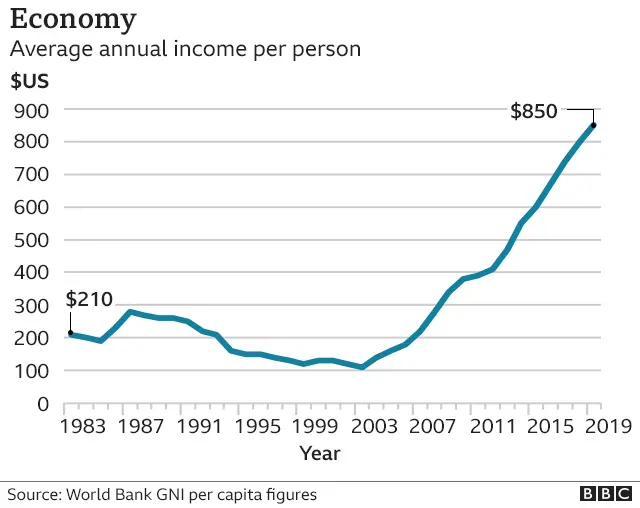
The BBC charts the dramatic changes in Ethiopia and the big challenges facing the country, as the nation prepares to vote in the first election since Prime Minister Abiy Ahmed came to power in 2018.





The next administration will govern more than 115 million people, making Ethiopia the second-most populous country in Africa after Nigeria and 12th in the world.
There are five times more people in Ethiopia now than there were 60 years ago, but the rate of population growth has slowed slightly over the last two decades.
It is predicted that there will be an additional three million Ethiopians every year up to 2050, when the country will be the world’s eighth most populous nation.




Ethiopia has gone through rapid economic transformation in recent years where population growth has more than been matched by economic expansion.
Things hit a low point in the drought years of 2002 and 2003, but since then the average income per person has increased by more than 600%.
That change, however, has not been experienced evenly across the country.
In the capital, Addis Ababa, the growth has meant urban expansion and infrastructure improvements like the introduction of the city’s light railway.
But in other parts of the country, some have complained that they have not benefitted from the economic growth – an accusation that has fuelled political protests in the past.




Changes in Ethiopia have also been reflected in improvements in health.
In the past 50 years there has been a dramatic decline in the number of deaths of children under five.
The proportion of women dying in child birth has also fallen.




The country is made up of a large number of ethnic groups and relations between them are likely to have a big impact on Ethiopia’s future.
Ethiopia’s largest ethnic group – the Oromos – had long complained that they had been marginalised both economically and politically.
A wave of protests beginning in 2015 in part led to the rise of Mr Abiy, an Oromo himself, to power.
He has been keen to foster a sense of national unity in the face of ethnic divisions, but also wants to celebrate that diversity.
Recent events though have proved a challenge to that vision.






Ethiopia has a federal system with 10 ethnically based states and two chartered cities.
Any ethnic group which does not have its own state can call for a referendum to create one.
Sidama was established in 2020 after a vote the year before and an 11th state could be created in the south-west following a referendum to be held in September.
This federal arrangement was laid out in the 1994 constitution in part to correct what was seen as over-centralisation under dictator Mengistu Haile Mariam. He was overthrown in 1991.
But last November, relations between the central government and Tigray in the north broke down with federal troops fighting soldiers loyal to the region’s former governing party. This was partly over a row sparked by accusations that Mr Abiy planned to make Ethiopia more centralised again.






The on-going fighting has led to a humanitarian crisis with more than 60,000 people fleeing across the border into Sudan and hundreds of thousands of others forced from their homes.
Massacres of civilians have been recorded as well as sexual violence. More than 350,000 people are said to be living in famine conditions, according to one assessment.
Overall, the UN estimates that more than five million people need humanitarian assistance.
The federal authorities replaced the Tigray People’s Liberation Front administration with an interim regional government, but there will be no election in Tigray because of the insecurity.
The fighting has highlighted the difficulty that Mr Abiy has in promoting his vision of unity while also respecting ethnic differences.






Violence has also flared up in several other parts of the country.
Some of it has been sparked by ethnic rivalries over land and boundary disputes.
In April, the government declared a state of emergency in part of Amhara region in an effort to deal with clashes between ethnic Amharas and Oromos.
Earlier in the month it was reported that 100 people died in a dispute over the border between the Afar and Somali regional states.
There has also been fighting in Benishangul-Gumuz, where survivors of an attack last December said members of the Gumuz community targeted people from other ethnic groups.
The federal government has frequently deployed federal troops to deal with the violence, but if he wins the election Mr Abiy will need to do more to address the violence that is threatening stability.
Why what’s happening in Ethiopia matters for Africa
Source





